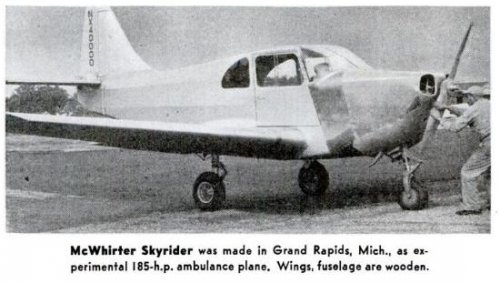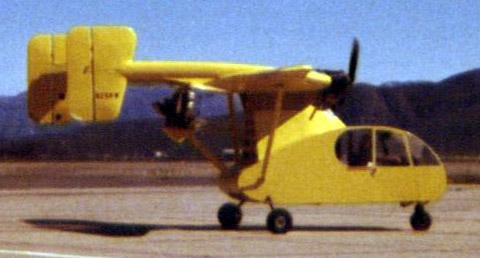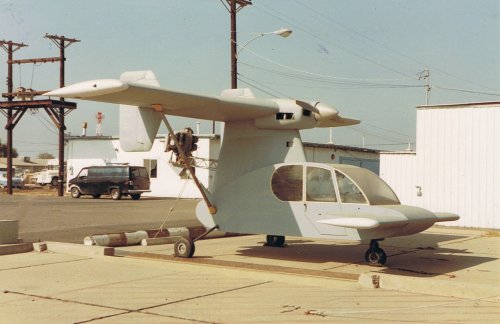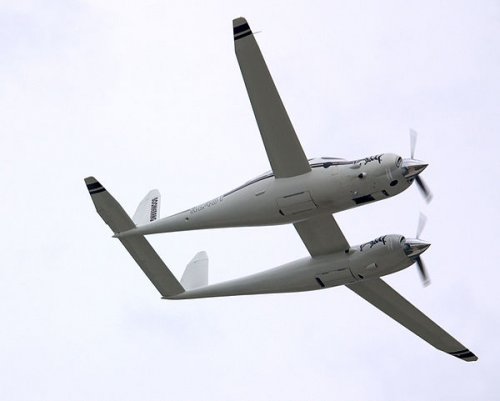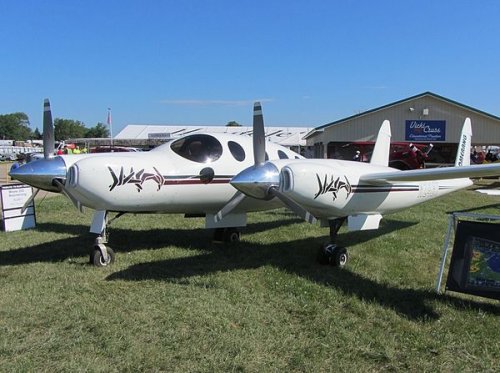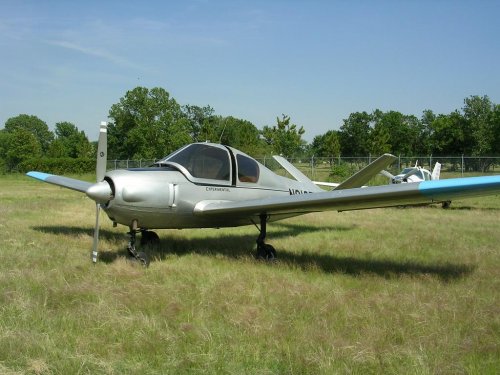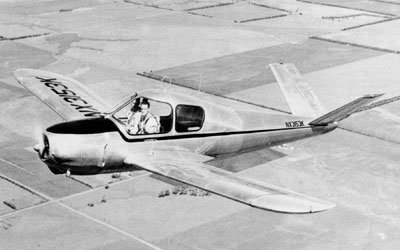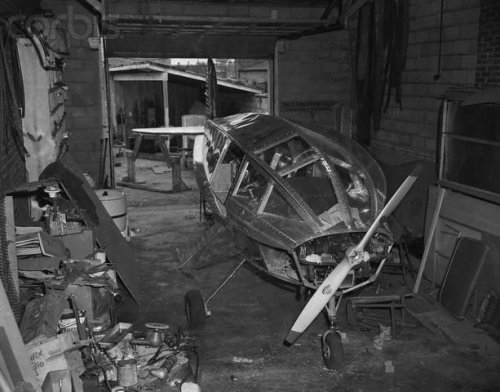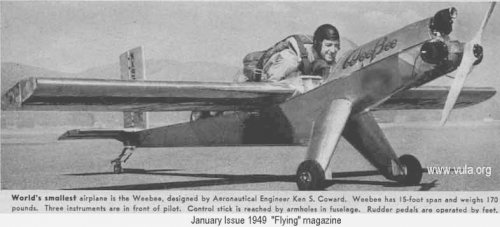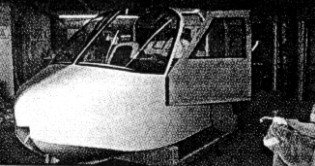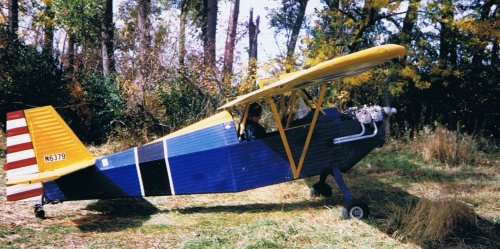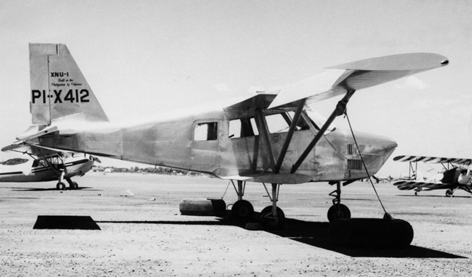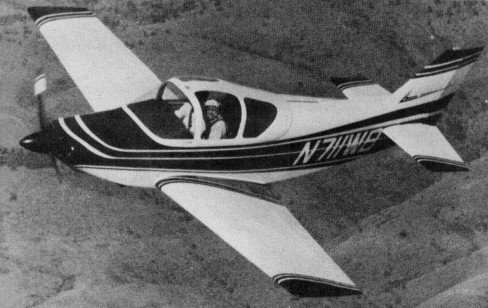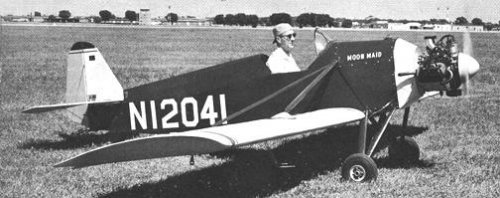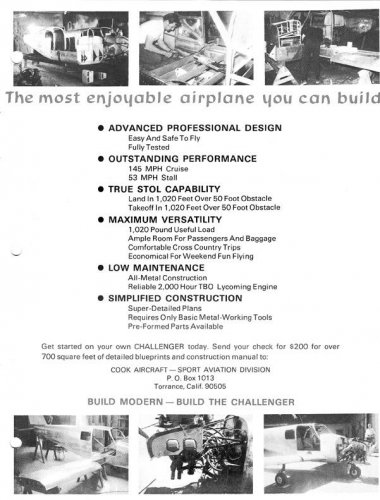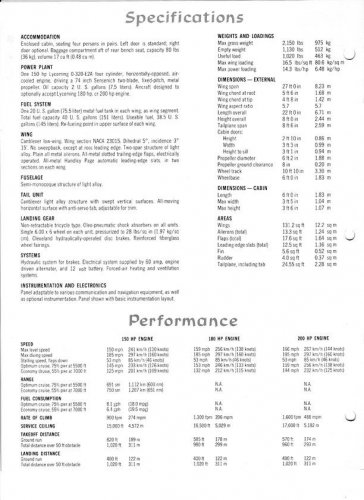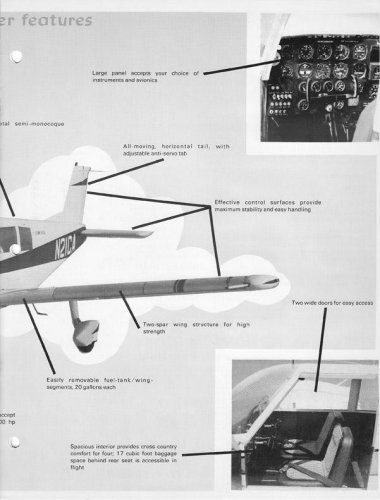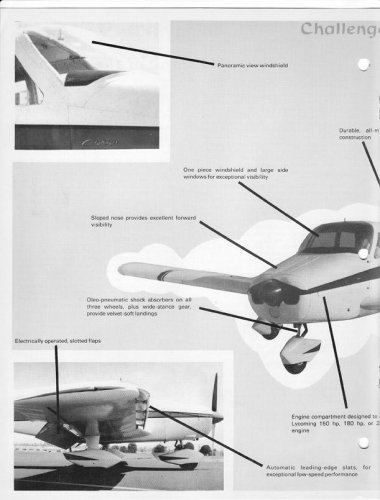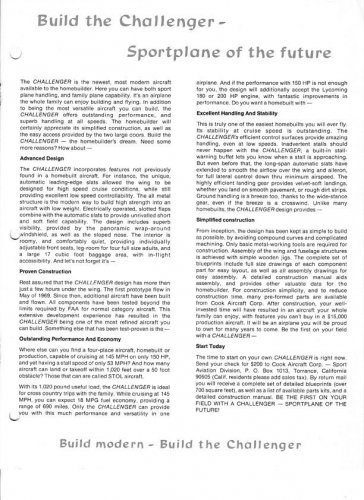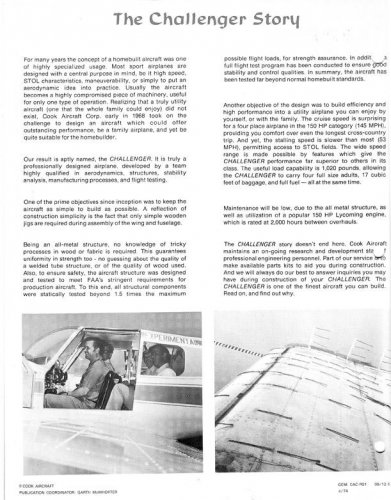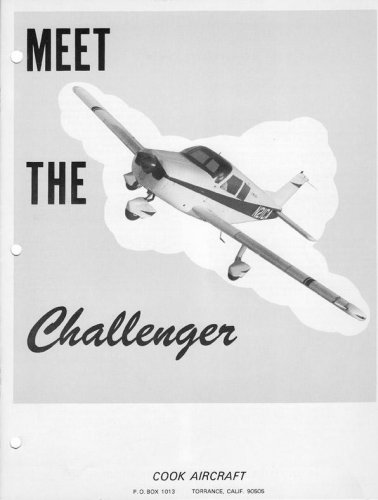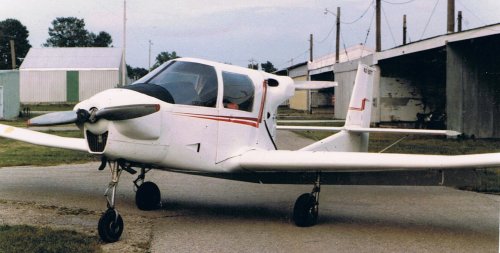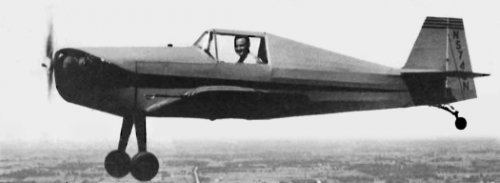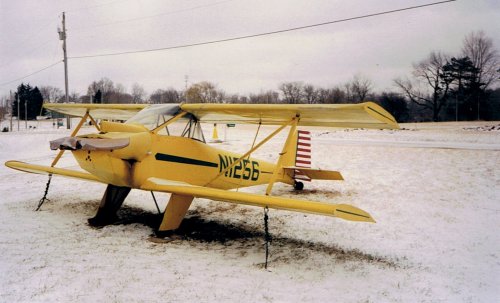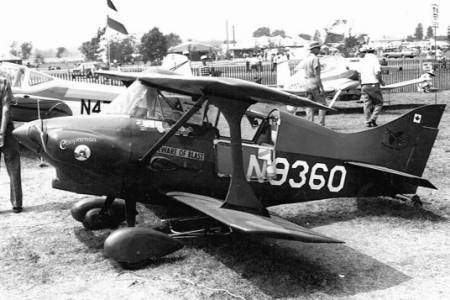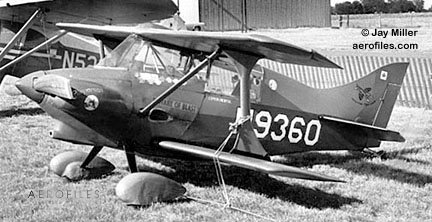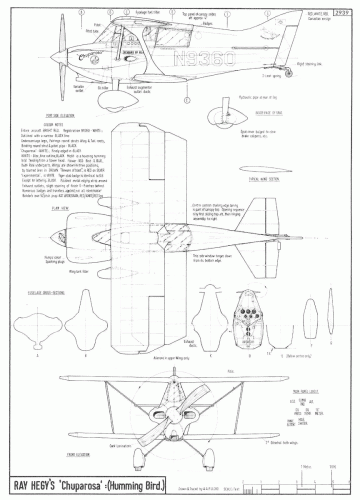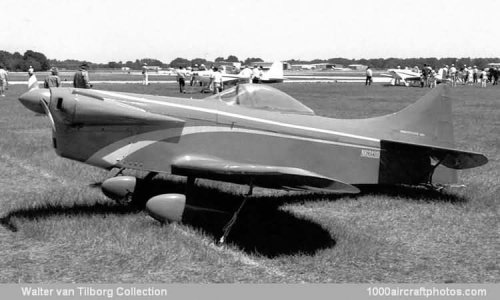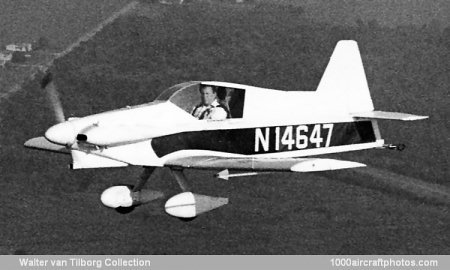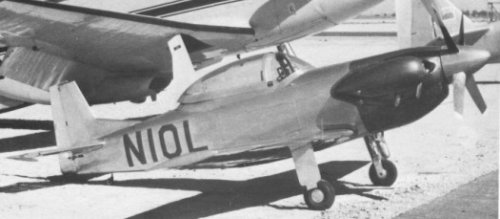You are using an out of date browser. It may not display this or other websites correctly.
You should upgrade or use an alternative browser.
You should upgrade or use an alternative browser.
All those weird and wonderful postwar homebuilt U.S. one-offs...
- Thread starter Stargazer
- Start date
The Unusual Rotor Wing Ultra-Stol (N25RW) was developed in California in the late-1970s. It was reported as the Ultra-Stol by a company named Rotor Wing System and reportedly the aircraft flew at least twice.
It had a relatively small wing and engines were reported as two Continental C85s and the rear could be tilted!. A very similar aircraft (maybe a rebuilt of the first?) was photographed by me in 1984 at Brown Field (near San Diego Ca), but it did not show a registration and was almost certainly never really completed. It differed in having a new wings, possibly from a Cessna Ce.150 and small canards. A company named High Technology Aircraft System, Inc (also in California). may be connected with this aircraft.
The yellow aircraft is N25RW, the other is the unregistered at Brown Field.
It had a relatively small wing and engines were reported as two Continental C85s and the rear could be tilted!. A very similar aircraft (maybe a rebuilt of the first?) was photographed by me in 1984 at Brown Field (near San Diego Ca), but it did not show a registration and was almost certainly never really completed. It differed in having a new wings, possibly from a Cessna Ce.150 and small canards. A company named High Technology Aircraft System, Inc (also in California). may be connected with this aircraft.
The yellow aircraft is N25RW, the other is the unregistered at Brown Field.
Attachments
- Joined
- 25 June 2009
- Messages
- 14,726
- Reaction score
- 6,060
walter said:this is the one at Brown Field.
Wow! Looks like someone found the remains of a crashed Britten-Norman Trislander and a crashed Dyke Delta and tried to piece the remaining parts together!!! Thanks a lot for sharing these rarities, Walter.
ksimmelink
Phormer Phantom Phixer
- Joined
- 25 June 2009
- Messages
- 14,726
- Reaction score
- 6,060
ksimmelink said:My all time favorite, is from the masters on one-off aircraft. Scaled Composites / Rutan. It is the Model 202 Boomerang. I saw it at Oshkosh one year and its quirkiness has always stuck with me.
You've got good taste. It is still Burt Rutan's own personal favorite!
Also, it almost got produced as the Morrow MB-300 Sky Taxi...
Allied A-2 (NX3153K
The A-2 was an original design by the Allied Aircraft Corporation and the first prototype (NX3153K) first flew on 9 April 1948 under the power of a 145hp Continental C145-2 engine. It was followed by a second prototpe (which was destroyed in a hangar fire) and a third example was not completed and development was then shelved. NX3153K was later extensively modified (around 1970?) by Mr. Thomas J. Ballentine who amongst others installed a 210hp Continental IO-360 and it was renamed as TJ-2 and registered N312TJ.
The aircraft is now in the collection of the Kansas Aviation Museum, Wichita, Ks and received it original designation back.
The A-2 was an original design by the Allied Aircraft Corporation and the first prototype (NX3153K) first flew on 9 April 1948 under the power of a 145hp Continental C145-2 engine. It was followed by a second prototpe (which was destroyed in a hangar fire) and a third example was not completed and development was then shelved. NX3153K was later extensively modified (around 1970?) by Mr. Thomas J. Ballentine who amongst others installed a 210hp Continental IO-360 and it was renamed as TJ-2 and registered N312TJ.
The aircraft is now in the collection of the Kansas Aviation Museum, Wichita, Ks and received it original designation back.
Attachments
Frenard (Arnoldi) Duck N69966
This single-seat amphibian/flying boat was designed and built by Mr. Fred N. Arnoldi (hence Frenard) and several colleagues of the Curtiss-Wright company. The aircraft was intended as flying scale for a planned (unbuilt) 4-seat aircraft and it was completed in 1948/1949 and then powered by a 50hp Continental A50. Many year later (in the 1970s) the aircraft was advertised for sale as the Bohmer Canard and it had been re-engined with a 65hp Continental A65. The aircraft is still on the FAA register as the Frenard Experimental. The Duck was claimed to be easy to convert for land or water use and the wing floats and landing gear were removable.
This single-seat amphibian/flying boat was designed and built by Mr. Fred N. Arnoldi (hence Frenard) and several colleagues of the Curtiss-Wright company. The aircraft was intended as flying scale for a planned (unbuilt) 4-seat aircraft and it was completed in 1948/1949 and then powered by a 50hp Continental A50. Many year later (in the 1970s) the aircraft was advertised for sale as the Bohmer Canard and it had been re-engined with a 65hp Continental A65. The aircraft is still on the FAA register as the Frenard Experimental. The Duck was claimed to be easy to convert for land or water use and the wing floats and landing gear were removable.
Attachments
patvig
ACCESS: Confidential
In my database, I found 2 Paraplane models : http://phpmyadmin.apinc.org/index.php?db=gpatvig_avions&token=88c4005e982b5ccb90ef6540591694e4#PMAURL:db=gpatvig_avions&table=avion&target=tbl_select.php&token=88c4005e982b5ccb90ef6540591694e4Archibald said:Edward Lanier "Paraplane".
http://www.1000aircraftphotos.com/PRPhotos/LanierParaplane1.htm
The Lanier (father and son) were convinced they had invented the best thing since bread came in slice. In fact they just re-invented Handley Page flaps of 1919... in the 40's.
They were aparently inspired by... ice cream cones inherent stability.
At least they build extremely-odd looking aircrafts that were detailed in Le Fana de l'Aviation 371 (year 2000).
The one below is one of the most "reasonable" designs they come by. Imagine the others. :

- Joined
- 25 June 2009
- Messages
- 14,726
- Reaction score
- 6,060
patvig said:
Thanks for the info. Even with two prototypes built, I think an aircraft type can still apply for "one-off"...
The link you provided doesn't work as it requires prior identification. Please correct it if you can.
patvig
ACCESS: Confidential
Sorry for giving alink to the database tool. This is the link to my website selection page : http://www.vignaud.org/Gestion_BD/Recherche.php and enter "Lanier" in the "Marque" field (Marque means brand).Stargazer2006 said:patvig said:
Thanks for the info. Even with two prototypes built, I think an aircraft type can still apply for "one-off"...
The link you provided doesn't work as it requires prior identification. Please correct it if you can.
- Joined
- 25 June 2009
- Messages
- 14,726
- Reaction score
- 6,060
Charles Pritchard of Emporia, Virginia, was a railroader by profession, which didn't keep him for having a go at aircraft making. And instead of playing it safe, he set out to build an all-aluminum wingless combined aircraft/car — no less! — which he said had been ten years in the making... and so was born the Rocket Air Ship.
The plane has short baffles or fins in place of wings, a 90 hp engine, a conventional propeller and tail assembly and a tricycle landing gear. It was 21 feet long, 98 inches wide and weighed 800 lbs. Pritchard made eight runs along runway, but — surprise, surprise — didn’t get off the ground...
More about that story:
http://news.google.com/newspapers?nid=1915&dat=19550608&id=zJArAAAAIBAJ&sjid=_nIFAAAAIBAJ&pg=1930,1315769
http://news.google.com/newspapers?nid=1298&dat=19550608&id=gQUUAAAAIBAJ&sjid=o4oDAAAAIBAJ&pg=7030,5159710
http://xplanes.tumblr.com/post/238382246/charles-pritchard-designer-builder-and-pilot
http://www.corbisimages.com/stock-photo/rights-managed/U1087329A/charles-pritchards-airplane
The plane has short baffles or fins in place of wings, a 90 hp engine, a conventional propeller and tail assembly and a tricycle landing gear. It was 21 feet long, 98 inches wide and weighed 800 lbs. Pritchard made eight runs along runway, but — surprise, surprise — didn’t get off the ground...
More about that story:
http://news.google.com/newspapers?nid=1915&dat=19550608&id=zJArAAAAIBAJ&sjid=_nIFAAAAIBAJ&pg=1930,1315769
http://news.google.com/newspapers?nid=1298&dat=19550608&id=gQUUAAAAIBAJ&sjid=o4oDAAAAIBAJ&pg=7030,5159710
http://xplanes.tumblr.com/post/238382246/charles-pritchard-designer-builder-and-pilot
http://www.corbisimages.com/stock-photo/rights-managed/U1087329A/charles-pritchards-airplane
Attachments
Corcoran Model 65-1 (N7558U)
A light biplane sport aircraft with an all-metal construction. This original design had two 8hp West Bend single cylinder/2-stroke engines on either side of the fuselage. The single-seat aircraft was a design of Mr. Stanley Corcoran and was built by the R.S.Corcoran company and first flew during 1966.
A light biplane sport aircraft with an all-metal construction. This original design had two 8hp West Bend single cylinder/2-stroke engines on either side of the fuselage. The single-seat aircraft was a design of Mr. Stanley Corcoran and was built by the R.S.Corcoran company and first flew during 1966.
Attachments
- Joined
- 9 October 2009
- Messages
- 21,928
- Reaction score
- 13,550
Stargazer2006 said:The Fogle V333 Sky Cat tilt-rotor was built in 1982 but never been flown. It was designed and built by Hal Fogle, who also worked on the SR-71 Blackbird program.
Photos below depict the prototype (now on display at the Carolinas Aviation Museum) and the full-scale mockup that preceded it, at some airshow.
Supposedly it was intended as a 'low cost CAS' aircraft.
http://www.arrse.co.uk/aviation/43945-whats-any-plane-spotters-2026.html
- Joined
- 29 August 2010
- Messages
- 598
- Reaction score
- 298
blackkite
Don't laugh, don't cry, don't even curse, but.....
- Joined
- 31 May 2007
- Messages
- 8,807
- Reaction score
- 7,675
blackkite
Don't laugh, don't cry, don't even curse, but.....
- Joined
- 31 May 2007
- Messages
- 8,807
- Reaction score
- 7,675
Hi gatoraptor  thanks for the nice picture of the WeeBee.
thanks for the nice picture of the WeeBee.
Hi blackkite thanks for the videos (or should I say films?).
thanks for the videos (or should I say films?).
The picture of gatoraptor is interesting. How many of us knew that the WeeBee initially had a tail wheel gear. I assume it never flew in that form. The original WeeBee had a Righter S-2-45 (military O-45) engine while the replica is quoted as having a Kiekhafer (according to aerofiles.com the Kiekhafer company later also built the Righter S-2-45). The S-2-45 (O-45) was built in versions from 20hp to 40hp.
One site reports that there were 2 versions of the WeeBee. Does anyone know whether they mean version 1 (tail wheel), version 2 (tri-gear), or is version 1 the original and version 2 the replica?
Hi blackkite
The picture of gatoraptor is interesting. How many of us knew that the WeeBee initially had a tail wheel gear. I assume it never flew in that form. The original WeeBee had a Righter S-2-45 (military O-45) engine while the replica is quoted as having a Kiekhafer (according to aerofiles.com the Kiekhafer company later also built the Righter S-2-45). The S-2-45 (O-45) was built in versions from 20hp to 40hp.
One site reports that there were 2 versions of the WeeBee. Does anyone know whether they mean version 1 (tail wheel), version 2 (tri-gear), or is version 1 the original and version 2 the replica?
Aero Wood Avocet 1A.
This 4-seat amphibian was a design of a company name Aero Wood Specialties, Inc. and work started around 1993. The aircraft had a largely all composite materials construction and the first example (a Model Avovet 1-A with a 300hp Lycoming IO-540-K1D5 engine) was under construction when the project was halted, possibly in/around 1998 and consequently the prototype was never completed. The general configuration was not unlike that of the Spencer Air Card (and other designs) with a pusher prop behind the cabin. I could not ascertain whether ever a N...number was assigned.
This 4-seat amphibian was a design of a company name Aero Wood Specialties, Inc. and work started around 1993. The aircraft had a largely all composite materials construction and the first example (a Model Avovet 1-A with a 300hp Lycoming IO-540-K1D5 engine) was under construction when the project was halted, possibly in/around 1998 and consequently the prototype was never completed. The general configuration was not unlike that of the Spencer Air Card (and other designs) with a pusher prop behind the cabin. I could not ascertain whether ever a N...number was assigned.
Attachments
Bowling X-Wind (N6379).
The X[Wind was a one-of-a-kind homebuilt of Mr. Jack Bowling and it first flew in 1974. The aircraft had a 80hp Continental A80 engine and featured a corrugated aluminum fuselage and tail covering, not unlike that of early Junkers. The aircraft had wings taken from a Luscombe 8. The registration was canceled in 2012.
The X[Wind was a one-of-a-kind homebuilt of Mr. Jack Bowling and it first flew in 1974. The aircraft had a 80hp Continental A80 engine and featured a corrugated aluminum fuselage and tail covering, not unlike that of early Junkers. The aircraft had wings taken from a Luscombe 8. The registration was canceled in 2012.
Attachments
Flemming XNU-1
Although built in the Philippines, I trust it will qualify as the designer/builder was American Mr. Jim Flemming. The all-metal aircraft was described as a 7-seater(?) and was reportedly briefly tested during the late-1960s or early-1970s. The engine was reported as a 185hp Lycoming.
Although built in the Philippines, I trust it will qualify as the designer/builder was American Mr. Jim Flemming. The all-metal aircraft was described as a 7-seater(?) and was reportedly briefly tested during the late-1960s or early-1970s. The engine was reported as a 185hp Lycoming.
Attachments
Barton B-1 Sylkie One (N711WB).
An advanced homebuilt two-seater by Mr. Wayne Barton and first flown on 2 May 1975. The aircraft had a fully retractable tri-gear and a 150hp Lycoming O-320 engine. The B-1 was initially built as personal transport for the designer, but later plans were made available for amateur construction and the type could accept engines in the 125-180hp range. No no additional aircraft were completed. The Sylkie One was winner of the 1979 EAA Outstanding New Design Award.
An advanced homebuilt two-seater by Mr. Wayne Barton and first flown on 2 May 1975. The aircraft had a fully retractable tri-gear and a 150hp Lycoming O-320 engine. The B-1 was initially built as personal transport for the designer, but later plans were made available for amateur construction and the type could accept engines in the 125-180hp range. No no additional aircraft were completed. The Sylkie One was winner of the 1979 EAA Outstanding New Design Award.
Attachments
Doyle ROG-1 Moon Maid (N12041)
The Moon Maid was one of USA`s first homebuilt aircraft to be powered by a VW engine. The aircraft was designed and built by Mr. Richard H. Doyle and started life as a gyrocopter (N1125). Mr. Doyle than decided to transform the gyrocopter to a low wing aircraft using the wings that had been manufactured by Mr. Phil Atlas for his (never built) homebuilt. The aircraft first took the air (now as N12041) in June 1964. The Moon Maid initially had a 25hp VW1200, later received a 50hp VW1600 and finally a 60hp VW1840. During its career the aircraft was modified several times and amongst others received a dorsal fin, a slightly enlarged vertical tail and a new cantilever undercarriage with wheel pants. Although plans were available for amateur construction (for engines in the 35-50hp range), no further aircraft were built.
Attached photo is from the B.C.F. Klein collection
The Moon Maid was one of USA`s first homebuilt aircraft to be powered by a VW engine. The aircraft was designed and built by Mr. Richard H. Doyle and started life as a gyrocopter (N1125). Mr. Doyle than decided to transform the gyrocopter to a low wing aircraft using the wings that had been manufactured by Mr. Phil Atlas for his (never built) homebuilt. The aircraft first took the air (now as N12041) in June 1964. The Moon Maid initially had a 25hp VW1200, later received a 50hp VW1600 and finally a 60hp VW1840. During its career the aircraft was modified several times and amongst others received a dorsal fin, a slightly enlarged vertical tail and a new cantilever undercarriage with wheel pants. Although plans were available for amateur construction (for engines in the 35-50hp range), no further aircraft were built.
Attached photo is from the B.C.F. Klein collection
Attachments
Durand XD-85
This was a 2-seat pusher designed and built by Mr. William H. Durand and the aircraft first flew during the Summer of 1948. The all-metal XD-85 was powered by a 85hp Continental C85-12J engine. The aircraft reportedly sustained wing damage in a hangar incident and was not rebuilt. Further development was halted, a fate not uncommon to many other (light) aircraft projects of the immediate post-war years.
Anyone knows the registration of the XD-85?
This was a 2-seat pusher designed and built by Mr. William H. Durand and the aircraft first flew during the Summer of 1948. The all-metal XD-85 was powered by a 85hp Continental C85-12J engine. The aircraft reportedly sustained wing damage in a hangar incident and was not rebuilt. Further development was halted, a fate not uncommon to many other (light) aircraft projects of the immediate post-war years.
Anyone knows the registration of the XD-85?
Attachments
- Joined
- 12 May 2008
- Messages
- 227
- Reaction score
- 460
Cook CA-1 Challenger
John Cook was trained in England and emigrated to the US to work on aircraft when the UK industry imploded in the 60's. After stints at several companies including Helio, he went to work for Northrop. I met him at there on the 747 (Northrop designed and built the center and aft fuselage) and after work in the evenings and on weekends, several of us went down to Torrance and helped production design this plane in return for stock in the company. We built a prototype and a static test article, intending to obtain an FAA Type Certificate. The aircraft first flew in May 1969 and performed well; it passed static tests with very minor fixes. During a spin test, the FAA pilot kept the power on during the first turn of the spin - we had always closed the throttle as it stalled - and the plane entered an unrecoverable spin mode. John and the FAA pilot parachuted to safety, but the plane N21CA fell into the LA Harbor. We built a second prototype, N72CA, and John Cook and John Parker test flew it to determine a safe aft CG limit. During one of these tests they got into the same situation and bailed out. JP was fine but Cook's parachute was hit by the spinning plane and he was killed.
The company continued for a while and a third prototype was completed (N123CA) and an attempt was made to market the project as a homebuilt. This was not successful, the company folded and the plane was sold.
John Cook was trained in England and emigrated to the US to work on aircraft when the UK industry imploded in the 60's. After stints at several companies including Helio, he went to work for Northrop. I met him at there on the 747 (Northrop designed and built the center and aft fuselage) and after work in the evenings and on weekends, several of us went down to Torrance and helped production design this plane in return for stock in the company. We built a prototype and a static test article, intending to obtain an FAA Type Certificate. The aircraft first flew in May 1969 and performed well; it passed static tests with very minor fixes. During a spin test, the FAA pilot kept the power on during the first turn of the spin - we had always closed the throttle as it stalled - and the plane entered an unrecoverable spin mode. John and the FAA pilot parachuted to safety, but the plane N21CA fell into the LA Harbor. We built a second prototype, N72CA, and John Cook and John Parker test flew it to determine a safe aft CG limit. During one of these tests they got into the same situation and bailed out. JP was fine but Cook's parachute was hit by the spinning plane and he was killed.
The company continued for a while and a third prototype was completed (N123CA) and an attempt was made to market the project as a homebuilt. This was not successful, the company folded and the plane was sold.
Attachments
Brenning B-Liner (N285TT)
Mr. Orin Z. Brenning started work on his B-Liner push/pull two-seater in 1970 and the aircraft was completed in 1986 with the first flight taking place on 31 July of that year. The aircraft featured a mixed wood, steel, composites construction and was purely intended for personal use, so no plans/kits were made available. The B-Liner was powered by two 85hp Continental C85-12 engines.
Some details: wingspan 34ft, length 23.667frt, height 8.254ft.
max. speed 158mph, cruise 144mph, climb 1,400ft/minute, ceiling 13,000ft, range 420 miles
Photo courtesy Mr. Brenning
Mr. Orin Z. Brenning started work on his B-Liner push/pull two-seater in 1970 and the aircraft was completed in 1986 with the first flight taking place on 31 July of that year. The aircraft featured a mixed wood, steel, composites construction and was purely intended for personal use, so no plans/kits were made available. The B-Liner was powered by two 85hp Continental C85-12 engines.
Some details: wingspan 34ft, length 23.667frt, height 8.254ft.
max. speed 158mph, cruise 144mph, climb 1,400ft/minute, ceiling 13,000ft, range 420 miles
Photo courtesy Mr. Brenning
Attachments
patvig
ACCESS: Confidential
In my dababase I have a plane referenced JC-1, first flow at the same date, and 3 made too. Is it the same plane ?BillRo said:Cook CA-1 Challenger
John Cook was trained in England and emigrated to the US to work on aircraft when the UK industry imploded in the 60's. After stints at several companies including Helio, he went to work for Northrop. I met him at there on the 747 (Northrop designed and built the center and aft fuselage) and after work in the evenings and on weekends, several of us went down to Torrance and helped production design this plane in return for stock in the company. We built a prototype and a static test article, intending to obtain an FAA Type Certificate. The aircraft first flew in May 1969 and performed well; it passed static tests with very minor fixes. During a spin test, the FAA pilot kept the power on during the first turn of the spin - we had always closed the throttle as it stalled - and the plane entered an unrecoverable spin mode. John and the FAA pilot parachuted to safety, but the plane N21CA fell into the LA Harbor. We built a second prototype, N72CA, and John Cook and John Parker test flew it to determine a safe aft CG limit. During one of these tests they got into the same situation and bailed out. JP was fine but Cook's parachute was hit by the spinning plane and he was killed.
The company continued for a while and a third prototype was completed (N123CA) and an attempt was made to market the project as a homebuilt. This was not successful, the company folded and the plane was sold.
patvig
ACCESS: Confidential
Under Doyle brand name (same builder ?), I have 2 more aircrafts referenced in my database :walter said:Doyle ROG-1 Moon Maid (N12041)
The Moon Maid was one of USA`s first homebuilt aircraft to be powered by a VW engine. The aircraft was designed and built by Mr. Richard H. Doyle and started life as a gyrocopter (N1125). Mr. Doyle than decided to transform the gyrocopter to a low wing aircraft using the wings that had been manufactured by Mr. Phil Atlas for his (never built) homebuilt. The aircraft first took the air (now as N12041) in June 1964. The Moon Maid initially had a 25hp VW1200, later received a 50hp VW1600 and finally a 60hp VW1840. During its career the aircraft was modified several times and amongst others received a dorsal fin, a slightly enlarged vertical tail and a new cantilever undercarriage with wheel pants. Although plans were available for amateur construction (for engines in the 35-50hp range), no further aircraft were built.
Attached photo is from the B.C.F. Klein collection
- Oriole, flew in 1939, no details
- Vulcan, biplane 2 seater, no more details
- Joined
- 25 June 2009
- Messages
- 14,726
- Reaction score
- 6,060
The all-yellow experimental Pitt Yellow Jacket [N5745N] was a single-seat sportsplane designed and built by the brothers Bruce and Gilbert Pitt of Milwaukee, Wisconsin.
After the photograph was taken, "bullet" cowls were added to streamline the jutting four cylinders of the 85-h.p. Continental C-85-8 motor. The wingtips and tail assembly had chord-wise black stripes in imitation of the "Yellow Jacket"—an American type of wasp. The Yellow Jacket prototype clocked 150 m.p.h. and cruised comfortably at 130 m.p.h.
The balanced proportions of the overall design apparent in the picture belie the dimensions—span 14 ft. and length 19 ft.
After the photograph was taken, "bullet" cowls were added to streamline the jutting four cylinders of the 85-h.p. Continental C-85-8 motor. The wingtips and tail assembly had chord-wise black stripes in imitation of the "Yellow Jacket"—an American type of wasp. The Yellow Jacket prototype clocked 150 m.p.h. and cruised comfortably at 130 m.p.h.
The balanced proportions of the overall design apparent in the picture belie the dimensions—span 14 ft. and length 19 ft.
Attachments
Patterson IY67 Pipsqueek (N1256).
Mr. Elton L. Patterson was designer and builder of the unique single-seat Pipsqueek. The aircraft had negative stagger, a retractable undercarriage and was powered by a 40hp VW1500 engine. The construction was started in 1963 and N1256 made the first flight on 26 February 1968.
Mr. Elton L. Patterson was designer and builder of the unique single-seat Pipsqueek. The aircraft had negative stagger, a retractable undercarriage and was powered by a 40hp VW1500 engine. The construction was started in 1963 and N1256 made the first flight on 26 February 1968.
Attachments
Hegy RCH-1 El Chuparoso (N9360)
This was a single-seat enclosed cabin biplane designed and built by Mr. Ray Hegy, who was famous for his wooden propellers. Work on the aircraft started in 1950 and was it completed in 1959, making the first flight on 1 May of that year. The aircraft had a 65hp Continental A65 engine and a mixed steel tube/wood construction. The aircraft was donated to the EAA (AirVenture) Museum.
This was a single-seat enclosed cabin biplane designed and built by Mr. Ray Hegy, who was famous for his wooden propellers. Work on the aircraft started in 1950 and was it completed in 1959, making the first flight on 1 May of that year. The aircraft had a 65hp Continental A65 engine and a mixed steel tube/wood construction. The aircraft was donated to the EAA (AirVenture) Museum.
Attachments
- Joined
- 25 June 2009
- Messages
- 14,726
- Reaction score
- 6,060
Hoffman X-1 Sweet Patootie (N6313D)
Mr. Edward C. Hoffman, during the 1960/1970s, produced several original homebuilt designs and his
X-series included the X-1 and X-3 single-seat land planes. In addition Mr. Hoffman built several flying boats (X-2, X-4 abd X-5) and made maximum use of the Florida weather and available water areas. Must have been a lot of fun!!
The X-1 was first flown on 24 February 1960 and initially fitted with a 65hp Continental A65 engine. The following year N6313D was re-engined with a 90hp Continental C90 and it also received some modifications such as a tear drop canopy.
Mr. Edward C. Hoffman, during the 1960/1970s, produced several original homebuilt designs and his
X-series included the X-1 and X-3 single-seat land planes. In addition Mr. Hoffman built several flying boats (X-2, X-4 abd X-5) and made maximum use of the Florida weather and available water areas. Must have been a lot of fun!!
The X-1 was first flown on 24 February 1960 and initially fitted with a 65hp Continental A65 engine. The following year N6313D was re-engined with a 90hp Continental C90 and it also received some modifications such as a tear drop canopy.
Attachments
Hoffman X-3 The Girlfriend (N14647).
The X-3 was the second land plane of Mr. Edward C. Hoffman and first flew late-1974. At that time it was fitted with a 75hp Continental A65 engine. The A75 was later replaced by a 85hp C85 for an improved overall performance.
The X-3 was the second land plane of Mr. Edward C. Hoffman and first flew late-1974. At that time it was fitted with a 75hp Continental A65 engine. The A75 was later replaced by a 85hp C85 for an improved overall performance.
Attachments
Linn Mini Mustang (N10L)
The Mini Mustang was designed and built by Mr. Charles C. Linn and despite the small dimensions, the aircraft featured a retractable undercarriage. The Mini Mustang was built to approximately 45-50% scale of the P-51. The L-1 was the first example built by Mr. Linn and it first flew on 14 January 1962. It won the 1962 EAA Most Popular Aircvraft awarsd, but was lost in an acident. To replace the L-1, Mr. Linn then constructed a second example, the L-2 (also named Linns Mustang) with the same N10L registration. This second aircraft differed slightly in having a 4-bladed (instead of 3-bladed) propeller, larger tail surfaces, a smaller engine air intake, longer canopy and it was also a bit shorter with 13.5ft (against 13.833ft). Both aircraft were powered by a 125hp Lycoming O-290-G engine. Plans were markleted for amateur construction, but I never could establish whether additional aircraft were built (maybe 2?)
The Mini Mustang was designed and built by Mr. Charles C. Linn and despite the small dimensions, the aircraft featured a retractable undercarriage. The Mini Mustang was built to approximately 45-50% scale of the P-51. The L-1 was the first example built by Mr. Linn and it first flew on 14 January 1962. It won the 1962 EAA Most Popular Aircvraft awarsd, but was lost in an acident. To replace the L-1, Mr. Linn then constructed a second example, the L-2 (also named Linns Mustang) with the same N10L registration. This second aircraft differed slightly in having a 4-bladed (instead of 3-bladed) propeller, larger tail surfaces, a smaller engine air intake, longer canopy and it was also a bit shorter with 13.5ft (against 13.833ft). Both aircraft were powered by a 125hp Lycoming O-290-G engine. Plans were markleted for amateur construction, but I never could establish whether additional aircraft were built (maybe 2?)
Attachments
Similar threads
-
Little-known Chinese helicopter projects
- Started by persil
- Replies: 15
-
Bendix Aircraft's forgotten postwar designs
- Started by Stargazer
- Replies: 6
-
Edward Lanier's « Paraplane »... and other unnecessary designs
- Started by hesham
- Replies: 11
-
Nihon University/Okamura N-52 light plane
- Started by Stargazer
- Replies: 5
-
USAAF / USAF November 1945 Light Bomber Competition
- Started by RyanC
- Replies: 13

